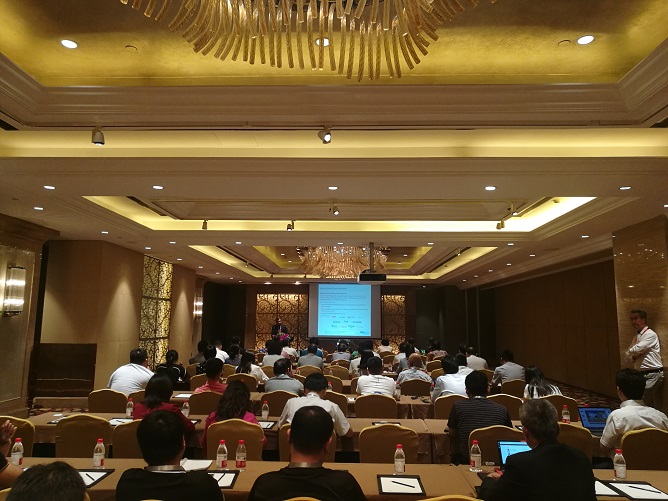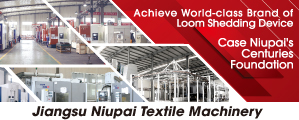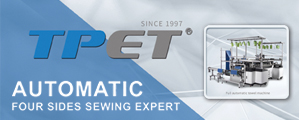Together, they explore the future of the world’s new fiber materials
The World New Fiber Materials Forum & The 24th China International Man-Made Fiber Conference (CIMFC) successfully held in Xiaoshan
Sep 11, 2018 | by Zhao Zihan
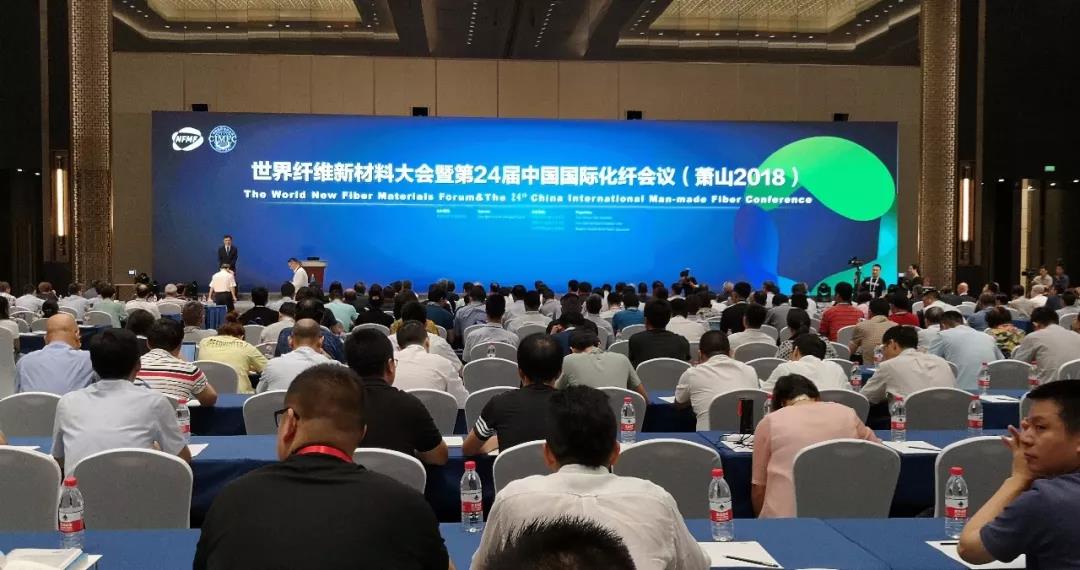
The World New Fiber Materials Forum & The 24th China International Man-Made Fiber Conference (CIMFC) kicked off on September 5th in Xiaoshasn, China. Themed on “Fiber Force Leading the New Future”, the two-day event consists of High Quality Fiber Development Forum, as well as the Parallel Sessions including “Advanced Technology in the Field of New Fiber Materials”, “High Performance Fiber and Composite Material”, “Technical Seminar with Aachen University”, and “Green Development and High Value of Fiber Industry Chain”, aiming to build an international communication platform for the latest achievements and applications of new fiber materials in order to advance the cooperation between the upstream and downstream of the industrial chain.
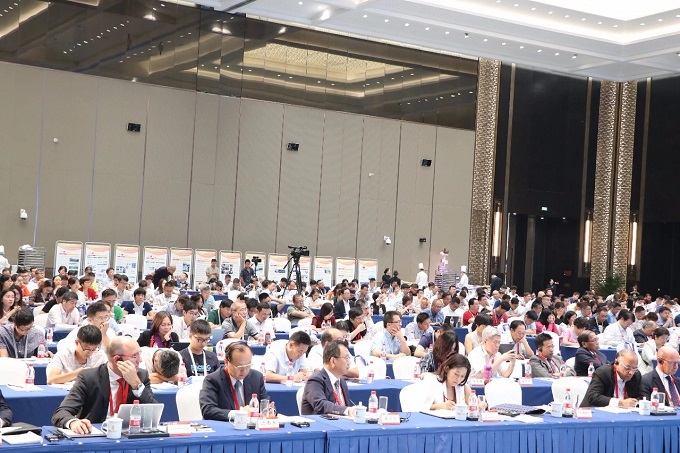
Domestic and overseas guests from nearly 20 countries and regions, such as the European Union, Japan, South Korea, Thailand, the United Kingdom, India, Chinese Taiwan, Chinese Hong Kong and Mainland China, attended the meeting, including experts, scholars and entrepreneur representatives from National Development and Reform Commission, Ministry of Industry and Information Technology, Ministry of Ecology and Environment, National Bureau of Statistics, China Council for the Promotion of International Trade, China National Textile and Apparel Council and several sub-industries including cotton textile, knitting, filament weaving, and textile machinery, relevant departments of Xiaoshan District, as well as various universities and institutes such as Donghua University, Beijing Institute of Fashion Technology, Tianjin Polytechnic University, Sichuan University, Zhejiang University, Southwest Jiaotong University, Jiangnan University, China Textile Academy, Hong Kong Polytechnic University, Taiwan Textile Industry Research Institute, Shanghai Textile Industry Technology Supervision Institute, University of California, and RWTH Aachen University. The opening ceremony of the conference was hosted by Duan Xiaoping, Vice President of China National Textile and Apparel Council & President of China Chemical Fibers Association.
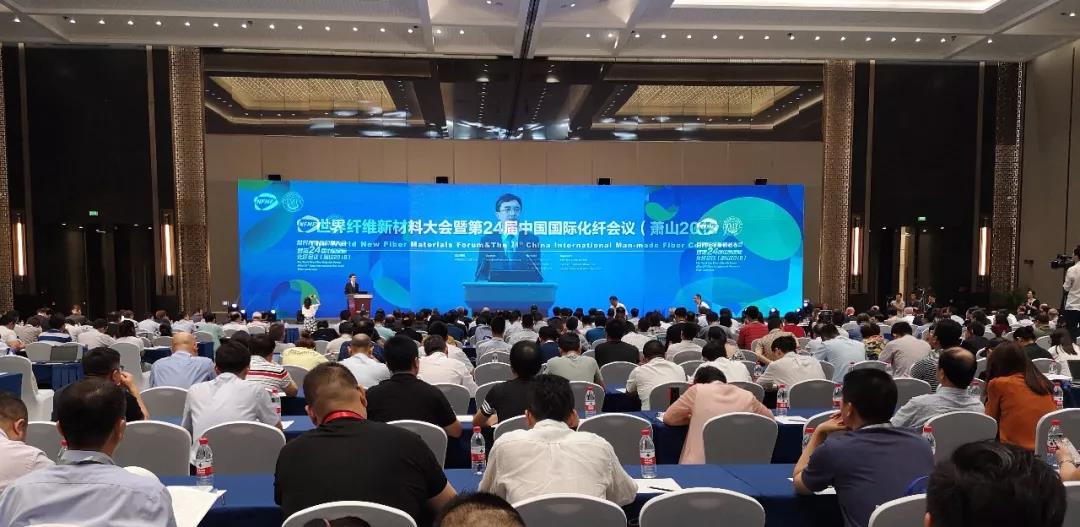
Wei Daqing, Deputy Mayor of Xiaoshan District Government, and Zhu Gejian, Deputy Director of The Economic and Information Commission of Zhejiang Province, respectively gave a welcome speech at the opening of the conference. The chemical fiber manufacturing industry is the largest traditional leading industry in Xiaoshan District. After 30 years of development, the scale of the industry has gradually expanded, the industrial chain has been increasingly perfect, and the status of the industry has become increasingly prominent. The elements of industrial technology and equipment are at the leading level in the country. It is the first national textile industry gathering base, including Hengyi, Rongsheng and other listed companies which ranked among the top 500 Chinese companies in 2017. At present, the headquarters’ chemical fiber capacity is 10.953 million tons, accounting for 22.16% of the country’s total, and 14.02% of the world’s total.
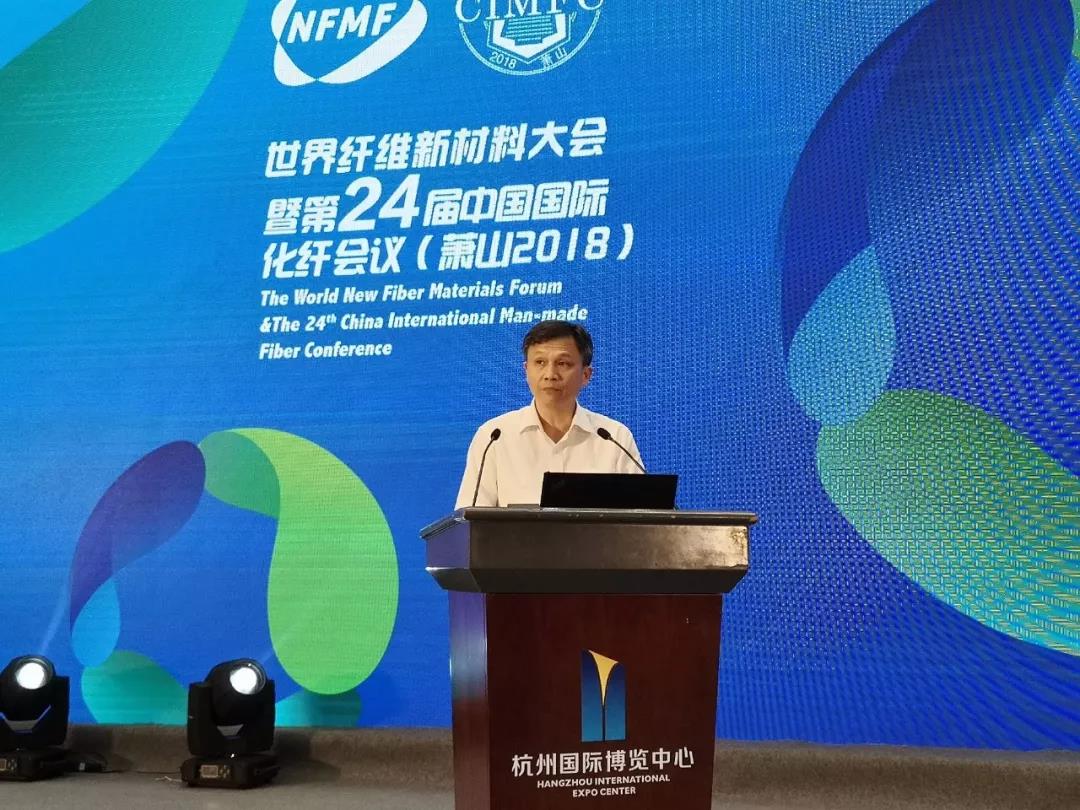
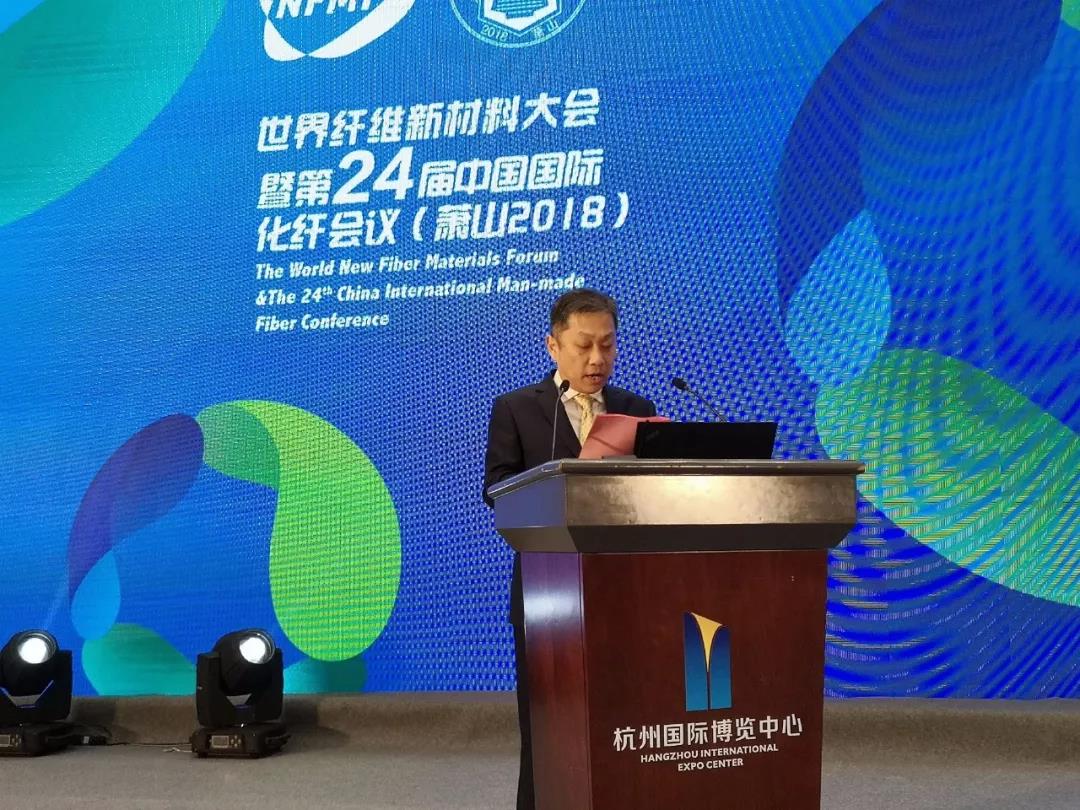
Gao Yong, Secretary General of China National Textile and Apparel Council, gave an opening address during the conference, putting forward that under the background of economic globalization and new technological revolution, China’s new fiber materials field has been committed to promoting learning, exchanges and cooperation with counterparts around the world. Its development is inseparable from extensive international exchanges and cooperation. The world also needs China which is not only an important market but also a manufacturing base.
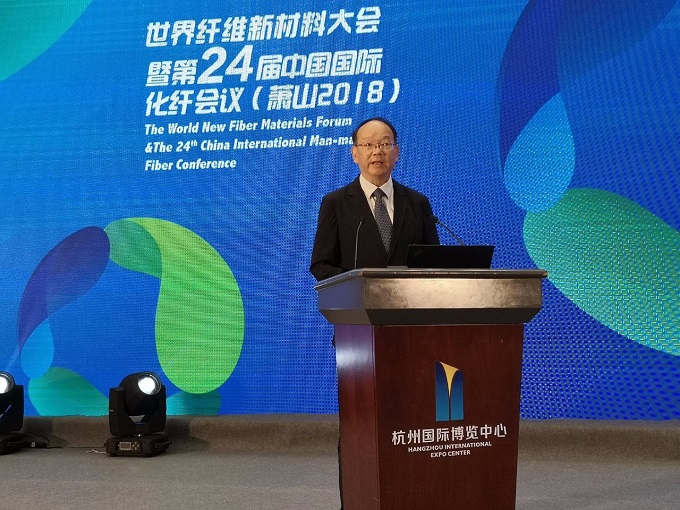
The conference has far-reaching significance in promoting the complementary advantages, the economic and technological cooperation and the sustainable development of the new fiber materials industry all around the world. It is also hoped that this conference will become a bridge and link for the discussion and communication of colleagues in the world of new fiber materials. The new thoughts and new assumptions of experts, scholars and practitioners from all walks of life will be brought together into new ideas and new measures for industrial development, to jointly promote the rapid development of the world new fiber materials industry.
The development of man-made fibers in China
Wang Xinzhe, Chief Economist of Ministry of Industry and Information Technology of China, stated that the 40 years of reform and opening up have profoundly changed the Chinese chemical fiber industry. In the past 40 years, China’s chemical fiber industry has maintained a sustained and healthy development trend, the scale of industry benefits has grown steadily, and structural adjustment has continued to deepen. At present, China has been already the world’s largest producer and consumer of chemical fibers, and its chemical fiber raw materials and chemical fiber products are exported to more than 100 countries and regions around the world. In 2017, China’s chemical fiber production was 47.14 million tons, accounting for 71% of the world’s chemical fiber production, ranking first in the world, which further consolidates China’s position in the global fiber industry. Over the past 40 years, China has emerged a group of excellent chemical fiber enterprises with strong innovation ability and outstanding manufacturing advantages, forming a group of world-class chemical fiber industry clusters such as Xiaoshan, Shengze and Changle. In the past 40 years, China’s chemical fiber industry has been actively promoting innovation, and the proportion of recycled fiber in total fiber processing has increased from 9.6% in 2010 to around 12% in 2017; high-performance fibers and bio-based fibers such as carbon fiber and meta-aramid have achieved technological breakthroughs.
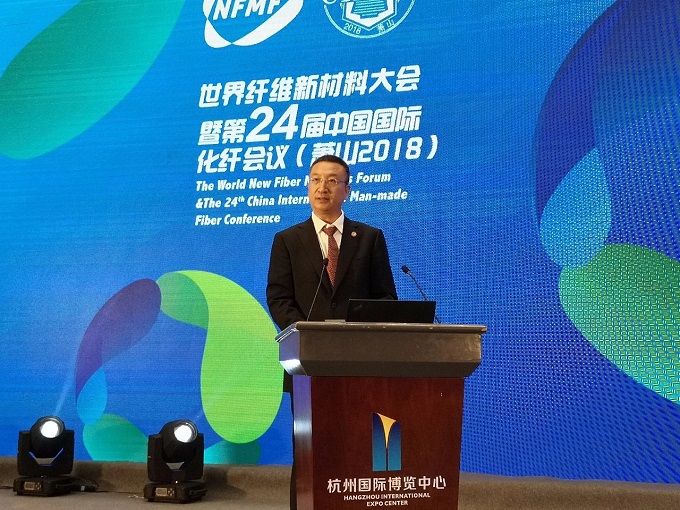
At present, the world chemical fiber industry and the special new fiber material industry are accelerating. The Chinese chemical fiber industry is facing tremendous transformation and upgrading pressures, for the R&D investment is seriously insufficient, the technological innovation system has not yet formed, and the proportion of industrial fiber is low. It is required to further deepen the supply-side structural reform to promote the chemical fiber industry to change the development mode, optimize the industrial structure, transform the growth momentum, and create a good development environment, so as to promote the high-quality development of the chemical fiber industry.
Duan Xiaoping, Vice President of China National Textile and Apparel Council & President of China Chemical Fibers Association, believed that reform and opening up has injected continuous vitality and momentum into China’s textile and chemical fiber industry. First of all, the reform and opening-up has brought about a fairly competitive environment for the development of the industry at home and abroad, especially the introduction of foreign capital, the reform of state-owned enterprises and the development of private enterprises. Secondly, reform and opening up has enabled us to better grasp the development direction, objectives and channels of the industry with broader vision especially after China’s accession to the WTO. Thirdly, reform and opening up will optimize the allocation of market resources. During this period, a large number of outstanding enterprises and entrepreneurs have grown up and become an important basis for the sustainable development of China’s textile and chemical fiber industry.
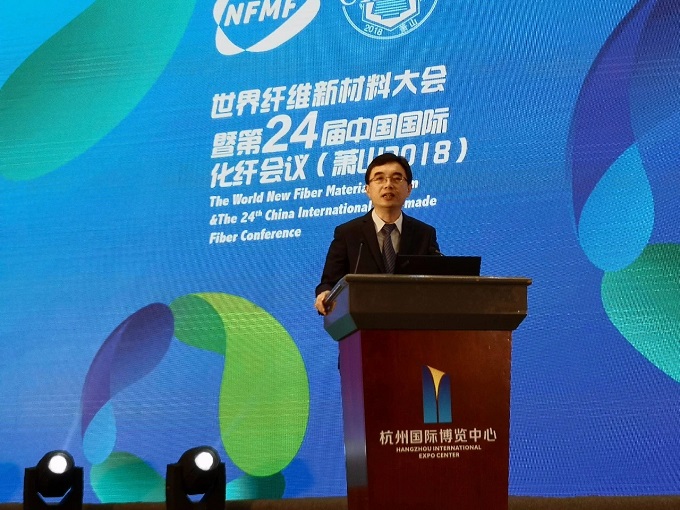
In the reform of the new era, the key is to correctly handle the relationship between the government and the market. In the future, to achieve high-quality development of the chemical fiber industry, he believes that the following aspects should be done: First, relying on science and technology to strengthen basic research and independent innovation of science and technology; second, adhering to green development and paying attention to sustainable development and social responsibility that integrate with the environment; Third, strengthening brand building at all levels of products, enterprises and industries to increase added value; Fourth, insisting on sharing for more “introduction” and “going global” at a higher level.
How to deal with China’s macroeconomic trends and Sino-US trade frictions?
Sheng Laiyun, Chief Economist of National Bureau of Statistics of China, delivered a keynote speech on China’s macroeconomic trends and high quality development in the new era, pointing out that since the beginning of this year, China’s macro-economy has continued the same trend as the last year, seeking progress while maintaining stability. The “progress” is mainly reflected in the optimization of internal structure, the improvement of development quality, as well as the stability, coordination and sustainability of economic operation.
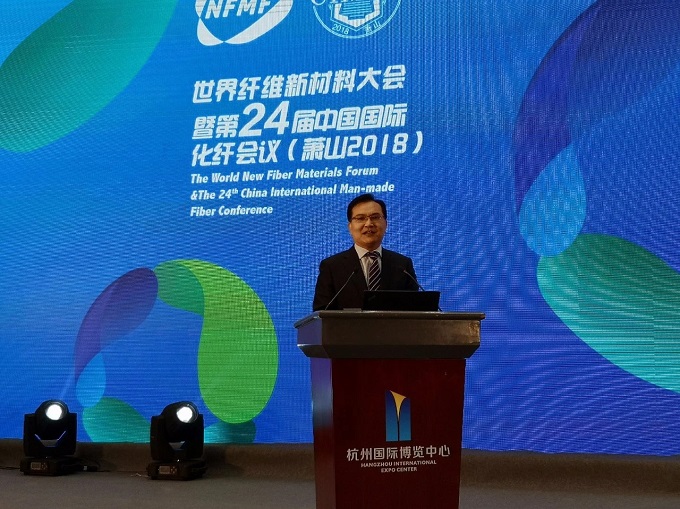
He stated that judging the future trend of China’s macro economy must firmly grasp the new trend of high-quality development of China’s economy in the new era. Economic growth has been successfully switched from high-speed growth to medium-to-high-speed growth, enjoying increased growth stability. The industrial structure is changing from industry-led to service-oriented, and the industry and service industries are moving toward the middle- and high-end. In the first half of this year, the demand structure was shifted from investment-led to consumption-driven, and economic rebalancing was optimized. Domestic demand, especially final consumption, has played a major role in the economy. The development mode has changed from epitaxial expansion to connotation development. The development goal is shifting from paying attention to economic growth to paying more attention to the development of people’s livelihood, attaching importance to the improvement of residents’ income, employment and environmental quality. After entering a new era, the internal structure of the Chinese economy has undergone profound changes, which has made the stability, coordination and sustainability of economic operations stronger. This is not only an important manifestation of high-quality economic development, but also a new opportunity for the development of the real economy. It is necessary to grasp China’s macroeconomic trends according to the new trend of economic development. To look at and evaluate the Chinese economy, we must not only look at speed, but also look at structure and quality. Otherwise, we will misunderstand China’s economic situation.
He proposed the following suggestions, first, accelerating reform and innovation to address the risk challenges of uncertainty with deterministic transformation and upgrading and high-quality development; Second, maintaining a certain strength to adapt to the new era and the new normal of economic development, firmly establishing a high-quality development thinking; Third, practicing the five development concept (innovative, coordinated, green, open and shared development), unswervingly promoting structural reforms on the supply side; Fourth, accelerating reform and opening up to create a good institutional guarantee for transformation and upgrading; Fifth, stabilizing the situation to scientifically coordinate the growth, promote the reform, adjust the structure, benefit the people’s livelihood, and prevent the risks.
Chen Huaisheng, Division Head of Department of Legal Affairs, CCPIT, talked about “The Impact of International Trade Protectionism and Globalization in Reverse Trends on the Industry and Its Response”, making a brief introduction to the concept and characteristics of international trade protectionism and globalization in reverse. He put forward suggestions for industry response. Firstly, to resolutely oppose trade protectionism and Globalization in Reverse, continue to adhere to multilateralism, and strengthen industry cooperation within the framework of the WTO system. Secondly, to continue to strengthen cooperation with Chinese industry enterprises, pay attention to the “Belt and Road Initiative” and pay attention to China’s continued reform and opening up. Thirdly, to strengthen rule analysis and theoretical research, strengthen dispute prevention, raise the level of compliance management and awareness of legal risk prevention.
Meanwhile, the enterprises are required to select market substitution in advance, integrate resource for global configuration, strengthen dialogue, consultation and lobbying, and seek support from China International Chamber of Commerce and other business associations to do product exclusion work.
The impact of petrochemical industry on the supply of chemical fiber raw materials
The petrochemical industry is a supporting and service industry for the chemical fiber industry. A good development trend of the petrochemical industry is a guarantee for better development of the chemical fiber industry. Bai Yi, Vice President of NPCPI, predicted that the total volume of the petrochemical and chemical industries will maintain steady growth in the next five years, while the market size will increase, the supply capacity will be optimized and upgraded, the industrial layout will be rationally allocated, and energy conservation will be further advanced. In the next 5 to 10 years, the petrochemical industry should resolve the contradiction between the industry’s production capacity development and market space, promote the transformation and upgrading of enterprises, advanced the comprehensive competitiveness, improve the scientific and intensive layout, and implement some industrial strategic shifts.
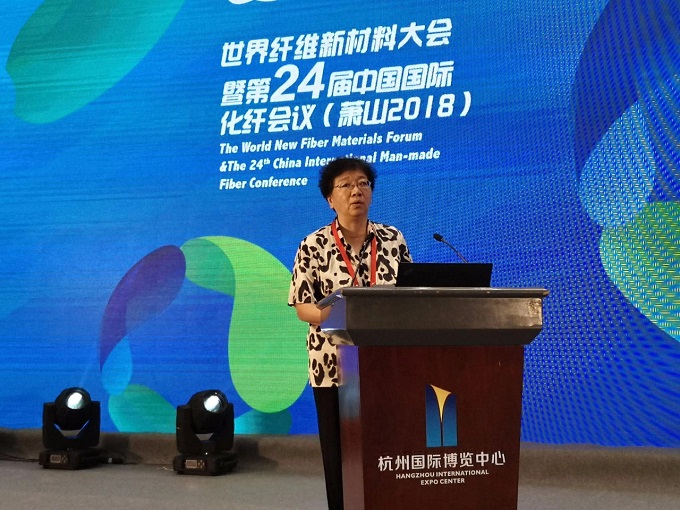
For the current situation of the refining industry, first, the crude oil processing capacity and resource utilization rate continue to increase; second, the diversified development trend of the main business entities is basically formed, and the completion and commissioning of large-scale private refining and chemical enterprises such as Zhejiang Petrochemical, Hengli Petrochemical and Shenghong Petrochemical will further intensify the market competition pattern; third, the device structure is continuously optimized. Especially the secondary processing capacity is significantly increased; fourth, the scale is continuously improved, and the high-quality production capacity of 10 million tons is increasing year by year, for example, the refinery single series device is becoming larger, and the capacity of atmospheric distillation single series has reached 12 million tons/year; the fifth is the continuous optimization of industrial layout, forming a pattern of “three circles and three belts”, namely, the three circles of the Bohai Sea, the Yangtze River Delta and the Pearl River Delta, and the three northeast, northwest and riverside belts.
In the industrial chain of PX-PTA-polyester, China’s current PTA and polyester production capacity is excessive, while PX production capacity is insufficient, and the supply and demand of the entire industrial chain is uneven. At present, some downstream PTA and polyester enterprises intend to enter the refining-aromatics industry. It is expected that the future development model of PX-PTA-polyester industry chain will become the mainstream of the industry. In the coming period, PX capacity construction will be concentrated. After 3 to 5 years, the PX market will enter a diversified competition situation, and PX will shift from a shortage state to a low-cost competition pattern. The petroleum route is still the main path for the development of China’s aromatics industry. The diversified development of aromatics raw materials depends on many factors such as the stability of raw material supply, cost competitiveness, and optimization of technical routes. At present, it is still necessary to vigorously improve and optimize the demonstration devices and explore them in depth, optimize the technical basis for diversified raw materials for aromatics, reduce production costs, and increase project competitiveness.
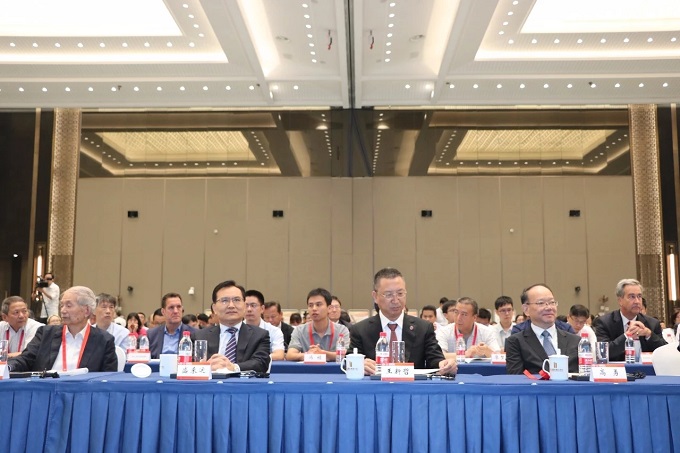
Future development trends of the world’s major fiber producing countries and regions
Hideshi UEDA, Executive Vice President & Director General of Japan Chemical Fibers Association, made a keynote speech themed on “Development Trend of Global Fiber Industry”, including brief explanation of global fiber demand trend, trend of high functional/high performance fibers and the importance of standardization, and recent developments in the Japanese chemical fiber/textile industry such as utilization of smart textiles and introduction of IT technologies.
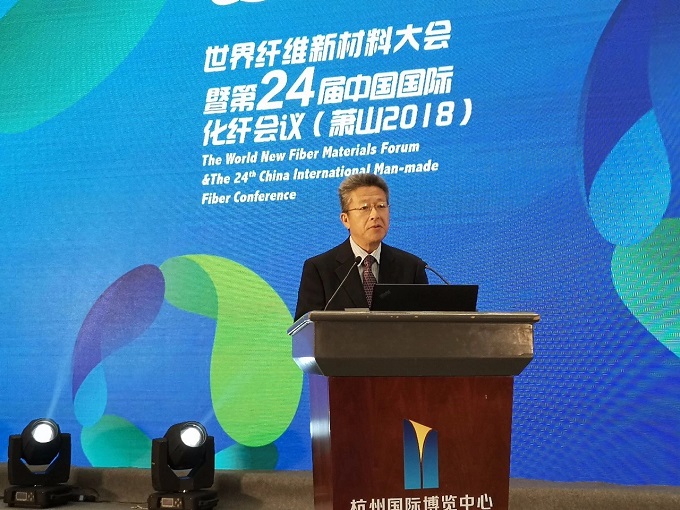
According to Hideshi, global fiber demand is growing supported by expansion in Asia, while global fiber industry’s growth is supported by chemical fibers. It is predicted that during 2017 - 2025, the chemical fiber will see a 3.2% annual growth.
He analyzed that the growth rate of high performance/high functional fibers is expected to be high. Standardization has become more important. Global fiber demand is increasing. With regard to commodity products, there are growing concerns about oversupply. On the other hand, demand for high functional fibers/high performance fibers is expected to continue expanding in the future. For high functional fibers/high performance fibers, it is necessary to establish international standards in order for ensure consumer safety and security and to raise awareness of the functionalities to final users. This will lead to new markets for chemical fibers.
He illustrated that the keywords for grasping future fiber demand are “Sustainability” and “IT/IoT/AI technology”. IT/IoT/AI technology may change the social structure system and may also change the global fiber demand/supply structure.
Andre Wissenberg, Vice President, Head of Marketing, Corporate Communications and Public Affairs of Oerlikon Man-made Fiber Segment, predicted that the man-made fiber industry will continue to benefit above average from the market growth and the shift of market shares from cotton to man-made fibers in the coming years. Polyester is the fiber number one. And, textile filament is experiencing the largest average growth per year with 3.8 percent. Oerlikon’s machine market is impacted by single measures. This has always been the case in the past and this will be also be in the future. There is no change. It’s a dynamic market that is difficult to predict. The long term average volume of the man-made filament and fibers machinery market will be in the magnitude of 2 billion Swiss franc. The new China policy on economics and reduced GDP does not shape the man-made fibers industry as expected in the 13th Five-Year Program. And, there is a positive development in other markets like India, in individual cases in turkey and last but not least also in the USA as well as in the rest of the world.
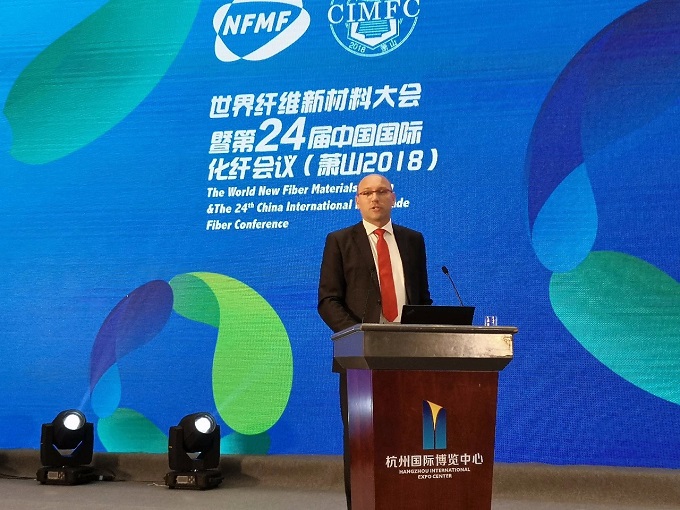
He stated hat the investment analysis of the Chinese market shows, that the downstream is in an obvious destock and restock process. The inventory of the filament industry has still been on a low level. “But if I look at the investment cycles of recent years, I see that after a long period of a lack of investments, there was always a peak in new investments. I also see a clear development in replacement investments as well as a consolidation and concentration of market participants. The current excellent financing opportunities and the trend towards mergers and acquisitions once again clearly support this. Last but not least, another technology upgrade is currently taking place. The age of digitization and automation has now definitely begun for China’s textile manufacturing industry.”
The next, more decisive step is already announced – Oerlikon Industrie 4.0 automated plant solutions. The “Digital Automated Factory” will increase an economic and efficient man-made fibers production in the future and will help control and reduce your OPEX expenses even better.
Andreas W. Engelhardt, General Manager of The Fiber Year GmbH, shared global trends in fiber applications, pointing out that several growth drivers exist to ensure that textile applications, ranging from apparel, home textiles to carpet and technical end-users will continue to expand. Today’s market size of fibers, yarns and polymer-based nonwovens accounting for 110 million tonnes, equal to 14.5 kg per head, to around 160 million tonnes by 2030 with projected world population of 8.5 billion. Demographics in favor of low and middle income countries will decelerate consumption for regular clothing. While functional textiles are on the upswing due to high price primarily in high-income countries. Main demand is for active and performance wear with antibacterial, temperature regulating, liquid repellent and uv-resistant functions. The technology increasingly meets design in casual and fashion clothing. In the future, water, energy and chemical products saving fashion, as well as clothing with enriched safety, comfort and performance level will influence the further trends of fiber materials.
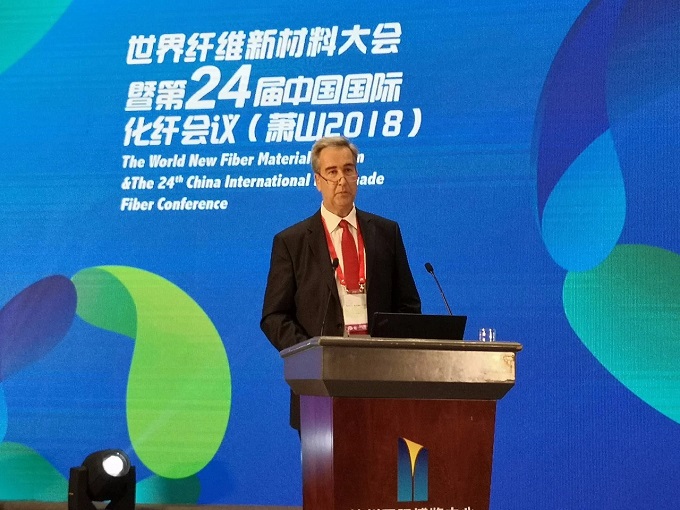
Ryan Aanderud, Vice President of Design Fujian Huafeng New Material Co. Ltd., innovation is not about making something different, but about improving something that already exists. Difference does not mean better. Through innovation, we will combine practicality, sexy and appropriate technology to create a better product. Every new product is an opportunity to create better things and an opportunity to tell a story. It is a hybrid of innovation and inspiration that drives the process of creating our products and drives our work.
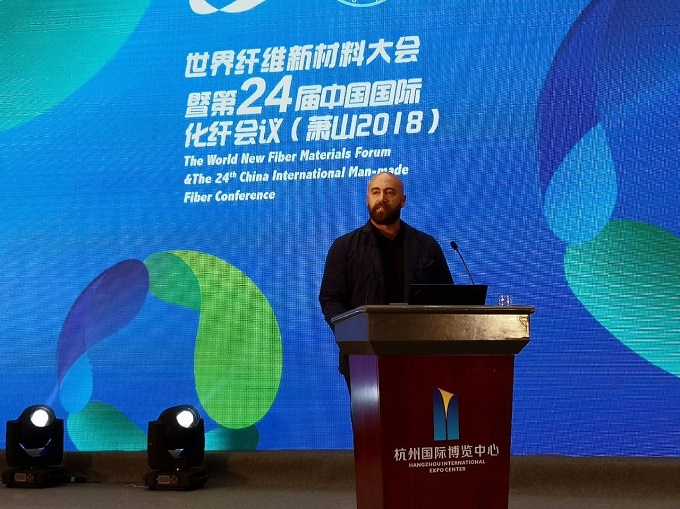
High-level talks
The high-level talks of the conference specially designed two dialogue sessions. Guests from EU, India, Thailand, China and other countries and regions talked about the development trend and challenges of the world chemical fiber industry from different angles, as well as the development advantages of each country and cooperation opportunities.
In the first session, the moderator Duan Xiaoping, Wei Daqing, Chinese Academy of Engineering academicians Jiang Shicheng and Yu Jianyong, Qiu Jianlin, President of Hengyi Group, and Li Shuirong, President of Rongsheng Petrochemical conducted in-depth exchanges around the following issues, including the reasons for China’s chemical fiber to have made great progress since China’s reform and opening up, the outstanding problems and bottlenecks in the chemical fiber industry, how to promote the development of China’s new fiber materials related industries through key technological innovations, how to better integrate enterprises’ own development with national major development strategies such as the National Belt and Road and Manufacturing Powers, and how national and local governments can positively guide and support further development of the chemical fiber industry from planning and policy.
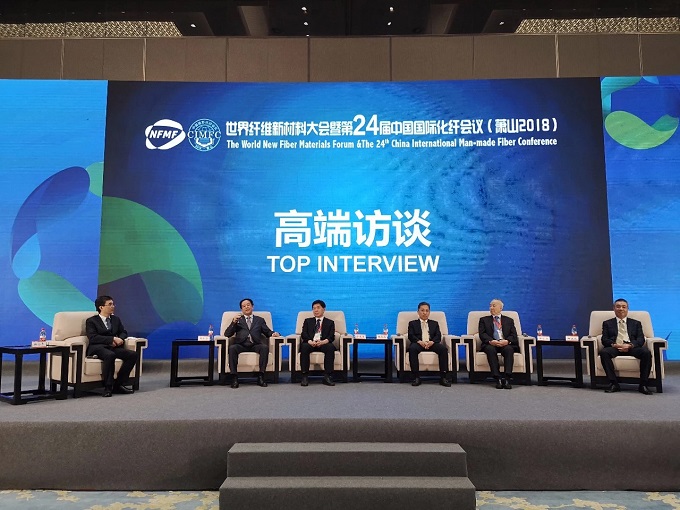
In the second session, the moderator Wang Jun, President of Oerlikon Group China, Frédéric VAN HOUTE, Director General of CIRFS and EATP, SC Kapur, Secretary General of Association of Synthetic Fiber Industry from India, Mayuree, Honorable Chairman of Thai Man-Made Fiber Industries Association, and Justin Huang, Secretary General of the Taiwan Textile Federation, discussed the current global textile chemical fiber industry pattern, the unstable or unpredictable factors in the international trade environment, and the deepening of China’s supply-side structural reforms. They also talked about how to maintain the characteristics and advantages of the domestic/local chemical fiber industry for more development opportunities and deeper cooperation.
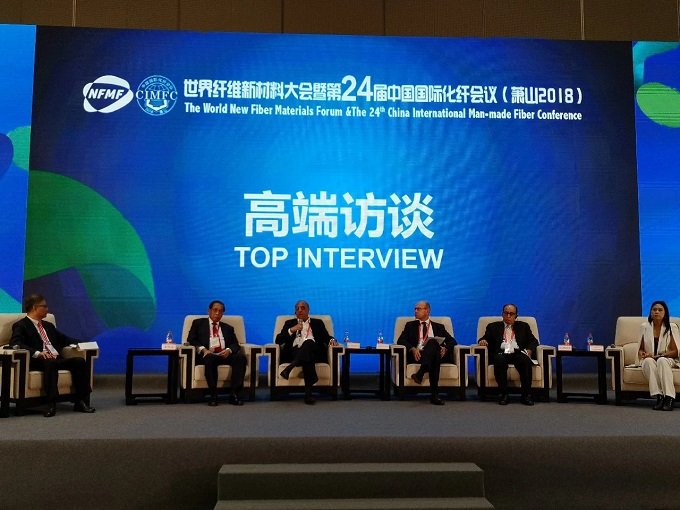
Frédéric VAN HOUTE, SCKapur, Mayuree and Justin Huang respectively shared the detailed work of the European chemical fiber industry in environmental protection and related regulations, the rapid development of non-garment fibers, fibrous composite and industrial textiles and some new initiatives in India, the new idea of the textile and chemical fiber industry in Thailand to enhance the value of the textile industry chain within the ASEAN, and the successful experience of the Taiwanese chemical fiber industry in combining functional product development with downstream demand.
Parallel forums
During the second day, the conference was divided into four parallel sessions for further discussion and exploration around different hot topics. The four parallel forums are “Advanced Technology in the Field of New Fiber Materials”, “High Performance Fiber and Composite Material”, “Technical Seminar with Aachen University”, and “Green Development and High Value of Fiber Industry Chain”.
The experts, scholars and entrepreneurs from around the world made speeches, and put forward their own proposals and ideas from different levels and technologies as well as various perspectives.
The two-day conference covered the major and difficult issues currently existed in the industry in the aspects of the overall chemical industry as well as the key species to be developed in the future development.
